Antarctica’s Great Climb
After an arduous time moving loads across 5 km of the white desert from base camp to advanced base camp we were poised to attempt the ridge. Leo had spent the morning with the enormous amount of climbing gear, getting his rack together, then, like an overburdened iron monger he stepped towards the massive wall and declared 'I'm exhausted, I feel terrible and there's ice in my boots. Let's do it.'
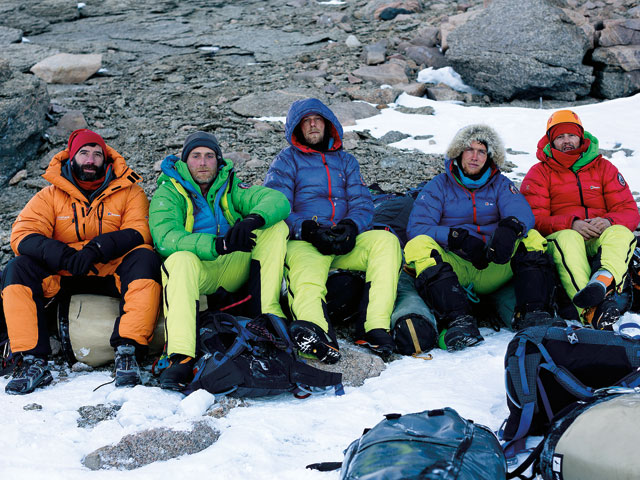
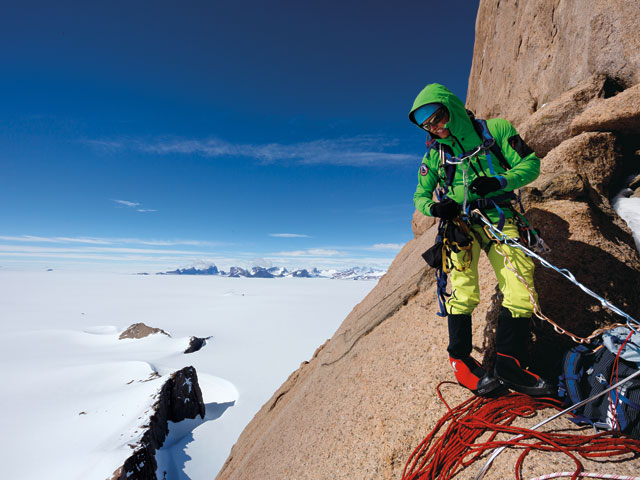
There I was, hanging on a fixed line on route to the ridge, totally out of shape, intoxicated by adrenaline and awe. Few things in life are as terrifying as jumaring on a single line on a big cliff. I spent a lot of the time convinced that the rope was about to cut and I would freefall down the face with my heavily laden sack of camera bodies. Coupled with the sheer physical exhaustion of jumaring twelve consecutive rope lengths were moments of amazement where I felt right out there. Indeed if Antarctica’s jaws were to snap me up it would have been an easy opportunity while I dangled like a puppet on a string.
The mountains of the Frenriskjeften range in northern Queen Maud Land, Antarctica represent a last-chance-saloon for today’s climber. The mountains are so remote and inaccessible that they were not explored until 1994. Ivor Tolleffson led a Norwegian expedition of 13 eclectic men to the area via a Russian icebreaker. Until then, they were one of the planet’s best kept mountaineering secrets.
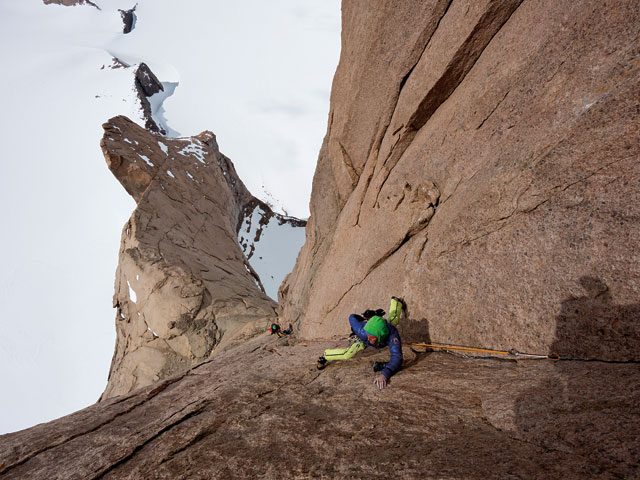
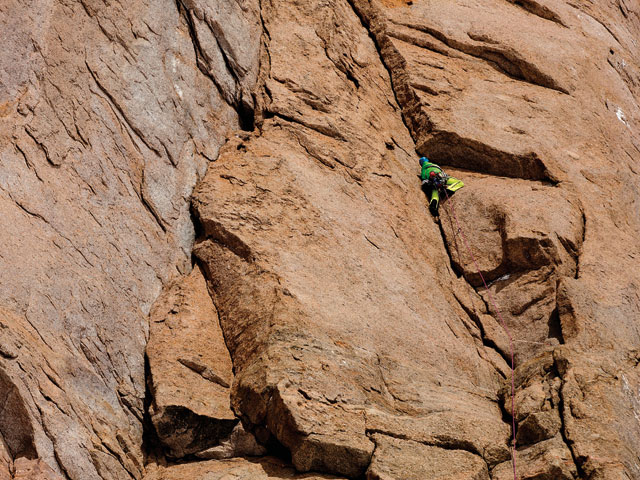
In 1938 Norway claimed Queen Maud Land and named it in honour of the Norwegian Queen, Maud of Wales. The mountains were first sighted and photographed from the air in 1939 by the Nazi Antarctic expedition. Whale oil was the leading fuel source of the time and with war approaching the Germans found their own supply of it. Large whale spotters were used to survey the landscape. Conspiracy theorists say they were looking for a secret base to hide the Third Reich should they loose the war. The planes flew over a small region in Queen Maud Land dropping iron crosses with swastikas on them and claimed an area within Queen Maud Land they named New Swabia.
When the Germans lost the war the Norwegians reclaimed New Swabia. In the late 1950s, Norwegians began photographic surveys. A dog sled team travelled north of the Fenriskjeften Range and photographed a collection of peaks with a large triangular summit poking clear of the horizon. It was that photograph, unseen for 35 years in the Norwegian’s Polar Institute’s archives that would inspire Tollefsen to organize an expedition. His motive was to find ‘the highest peak in Norway,’ recognizing that Queen Maud Land was Norwegian territory.
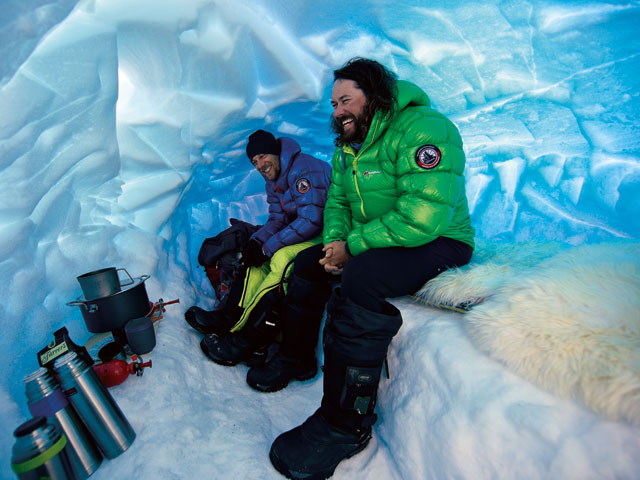
The 1994 expedition was successful and Tollefsen, along with top Norwegian climber Robert Caspersen, climbed many first ascents including the jewel of the range, Ulvetanna. After a thwarted attempt on the north face they eventually made an eight-day ascent of the west face. Tollefsen published a book about the trip showing the extraordinary beauty of this sublime area to the world for the first time. Virgin sheer granite spires slicing hundreds of metres clear of the Antarctic ice sheet create a stunningly pure aesthetic, in my opinion unequalled anywhere in the world.
In 1997, Tollefsen and a smaller team with the same climbers from the original trip explored an area further to the east. Upon arrival they were accompanied to the Russian science base Novolazarevskaya (Novo, the launch pad for expeditions to Queen Maud Land) by a US team including Alex Lowe and Conrad Anker, Gordon Whistler and Jon Krakauer. The National Geographic article about the US team and their ascent of Rakekniven Peak was my first exposure to the possibilities of Antarctica’s climbing. Pictures of the Himalayas or the Alps muster up those dreamy images of seeing yourself on far off summits. Images of Yosemite or Arapiles would start the cogs of psyche and you hope one day you would be there. When I saw the pictures of Queen Maud Land I thought I would never go there or have the required skills to climb in such an environment.



Leo Houlding, Sean Leary, Jason Pickles, Chris Rabone and I arrived on the blue ice runway at 4 a.m. December 16, 2012, and the area was more desolate than I was prepared for. All around was barren land with no permanent structures or population. We arrived to the news that the DC3 twin prop plane picking up a team from a camp at Holtanna Peak (also in the Fenriskjeften Range) had gone down on take off. The plane was a write-off but nobody was seriously injured. With an aircraft down our flight into Ulvetanna was now in doubt. At one point it was rescheduled by a week. Similar delays and fiercely poor weather had prevented Tollefsen and his familiar Norwegian team’s attempt on the north-east-ridge just 12 months earlier.
As we flew into the Fenriskjeften Range the next day, in less than perfect conditions, I tried to imagine what it must have been like for the Norwegians in their Russian helicopter flying towards Ulvetanna. Casperson, the lead climber on the 1994 expedition, described to me how the mountain grew proportionally to their excitement at what such a peak might mean for the sport of climbing. Cliffs of 1,000m or more are rare jewels, so rare that you can name most of them on one hand. It seems the world’s geological processes have resulted in a plethora of walls between 500-800m, many still unexplored and unclimbed. When it became apparent that the north face of Ulvetanna is comparable to El Cap and the east face is even bigger, the Norwegians knew they found a special mountain. The unclimbed NE ridge was the line of most aesthetic beauty, the masterpiece of the range.
The long knife-edge ridge, the line between shadow and light, has steep cracks, brilliant corners, roofs and overhanging off-widths that keep the creative mind busy. Despite photographs, increased knowledge and access to the area, the line was still unclimbed in 2012. Having the opportunity to travel to Fenriskjeften Range was the ultimate perk of my job as an adventure film maker. The culmination of being good at taking photos, having a wild ambition for mountain film making and the fruitful partnership with climber Leo Houlding resulted in my inclusion on the expedition to Antarctica.
It was almost three weeks into our expedition when we were finally in a position to begin the climb. After an arduous time moving loads across 5 km of the white desert from base camp to advanced base camp we were poised to attempt the ridge. Leo had spent the morning with the enormous amount of climbing gear, getting his rack together, then, like an overburdened iron monger he stepped towards the massive wall and declared ‘I’m exhausted, I feel terrible and there’s ice in my boots. Let’s do it.’
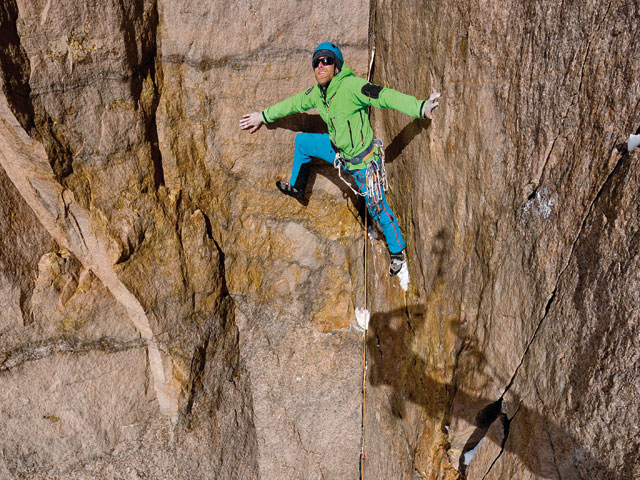

At 12 a.m. on day 25 I was alone on the ‘Dinosaur’s Back,’ an exposed section of ridge. The rest of the team was lower on the wall hauling 300 kg of gear up fixed lines below our bivy ledge. I looked up at the rock above as the wind blew with force. I had not eaten or drank as much as an energy-gel in 12 hours and the unusual angle of the ridge and crazy exposure had me a little stumped as to how to proceed. I decided to wait on the hanging belay for a bit of moral support from the rest of the crew. That didn’t last, as waiting around only increased my anxiety, so I climbed onto the ridge with my jumars on the sagging fixed line and feared a pendulum if I put my bodyweight onto it. The next 40 minutes became one of the most blood-curdling experiences of my life as I free climbed the ridge, using jumars on the fixed line as a belay. I think the initial shock from exposure of the 500m drops on either side of the ridge instinctively made me stay close to the rock and not risk standing up and loosing my balance.
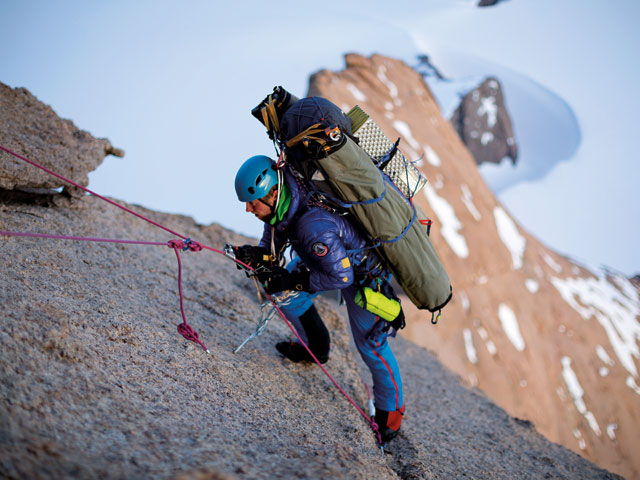

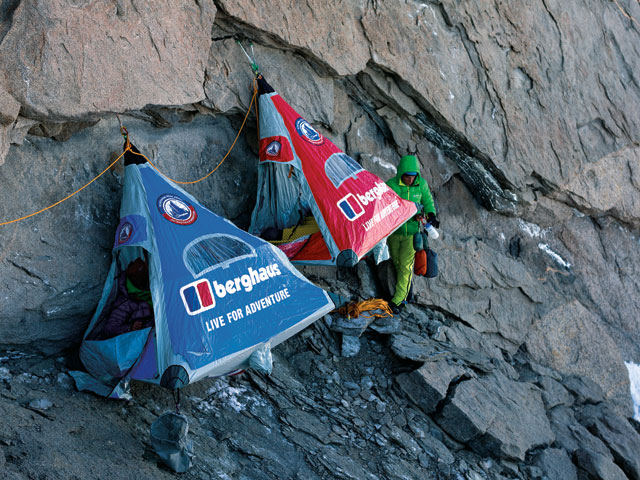

Two days later I had been up and down the ridge several times, moving with increasing ease. I was helping to shift loads of gear and photograph Leo re-leading the pitches. Leo and Stanley are true adventurers who stepped into the unknown with each pitch: 5.12 corners, overhanging cracks, off widths and chimneys. Despite the increasingly cold and windy conditions on the mountain, if we just kept pushing the rope a couple pitches higher each day without overextending ourselves eventually we would reach the top.
Leo sat on the summit rock looking relaxed and content but eager to keep things moving as it was very cold. Leo knew that getting good shots on the summit is as important as any other part of an expedition. This was one of the key reasons I was the twelfth person to stand on the summit of Ulvetanna and the second behind Leo to complete the NE ridge. Accidentally, my film making made me a big wall alpinist. It’s worth pointing out that one of the main reasons for our success was some unprecedentedly good weather. For almost a month we had been treated to blue skies and almost no wind. A few hundred metres below the summit, the weather started to turn and get worse but not enough to put us off a summit bid.
The remoteness of the area is really hard to overemphasize and the one thing everybody who has been there seems to agree on is that you feel isolated. There are no means to a rescue and you are a long way from anything edible. The situation was best summed up by the everyman of our expedition: the working class hero Jason Pickles. During our New Year’s Eve celebrations Pickles declared ‘I’ve just realized I’ve never been this far away from a policeman.’ This was from the relative comfort of our deluxe base-camp. Thanks to the meticulous organization of expedition master Leo Houlding, our camp was near perfect. I think the fear of what could go wrong on this serious and extreme camping holiday had Leo in preparation overdrive. Every eventuality had been thought through and accounted for.
We cracked open champagne while wearing party hats and down suits on the icecap. Momentarily, we were in the shadow of Ulvetanna as the midnight sun dipped behind the mountain. At the end of our New Year’s Eve celebration we had bomb-proof tents and minus forty sleeping bags waiting for us.
The general perception is that brilliant climbers like Leo and Stanley are a bit crazy. The truth is that they have a methodical approach; everything is carefully weighed up and considered. Under Leo’s superb leadership after eight days on the wall and 17 climbing days in total we were all back on the glacier feeling exhausted, elated and glad to be alive. There was still a mammoth amount of work to do, but at least no more hanging on fixed lines. We survived the double suffer-fest of big wall climbing and polar exploration and accomplished a big first ascent.
As we flew out over the mountain range it was hard to argue that the granite triangle poking up from the ice sheet was not one hell of an impressive line. While I was in Antarctica I felt very vulnerable. The conditions were excellent but it could still turn bitterly cold in the blink of an eye and you knew that any little mistake with a lost glove or holding a camera for too long in an exposed position could have dire consequences.





I think there will always be a last great problem for climbers. Maybe there is scope for other mountains to be discovered, hidden on some corner of the map, although I am doubtful. The important thing is to take on challenges. My filmmaking follows similar motives to cutting edge climbing in that I’m excited and motivated to take on a project if it is breaking new ground and hasn’t been done before.
Perhaps it’s appropriate to end with the final excerpt from my diary which I wrote as we laid on the ice waiting for the DC-3 to pick us up:
‘When you’ve searched every corner of the world, seen all the wild lands and stood on every summit. When every recess of your mind is expended and every part of your body spent. When you can suffer no more, maybe you can summon the courage, cease the energy, pass on the inspiration and keep searching, as somewhere out there in somebody’s mind is the last great climb.’
Alastair Lee is a climber and film maker based in the UK. Route Summary: Ulvetanna NE ridge first ascent Jan 2013: Leo Houlding, Sean ‘Stanley’ Leary, Jason Pickles, Chris Rabone and Alastair Lee (David Reeves ground support) E6 6b, 5.12a, A2, 33 pitches, 1,750m. A film about the expedition is due out in Nov 2013 www.posingproductions.com


